Financial Systems and Economic Growth
VerifiedAdded on 2020/01/28
|10
|3695
|402
Essay
AI Summary
This essay discusses the importance of financial systems in the global economy, detailing their functions such as capital formation, liquidity, and risk management. It analyzes the role of financial markets and intermediaries, the impact of monetary policies, and the consequences of financial crises. The essay also covers various financial products and investment strategies, providing a comprehensive overview of how financial systems contribute to economic growth.

Essay
Paraphrase This Document
Need a fresh take? Get an instant paraphrase of this document with our AI Paraphraser
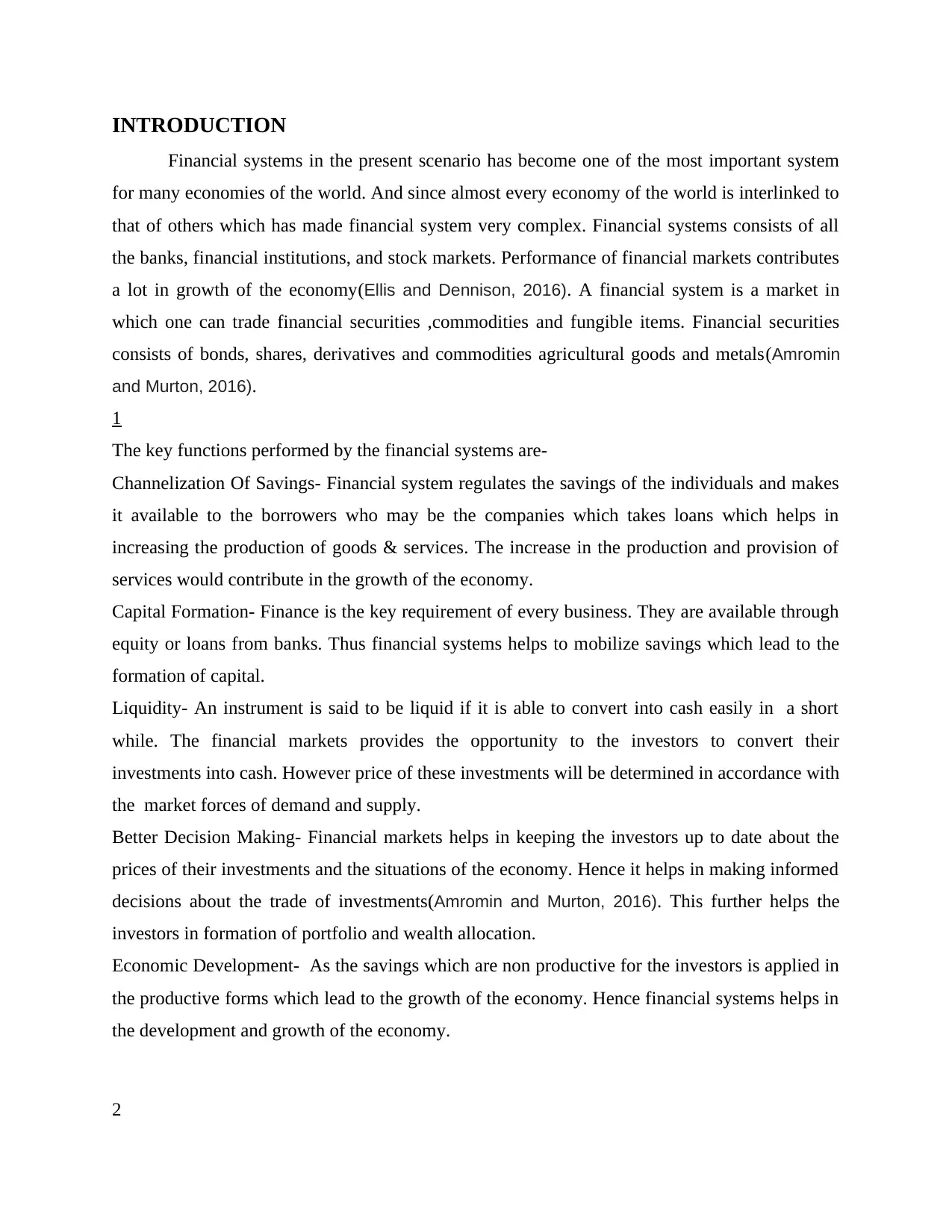
INTRODUCTION
Financial systems in the present scenario has become one of the most important system
for many economies of the world. And since almost every economy of the world is interlinked to
that of others which has made financial system very complex. Financial systems consists of all
the banks, financial institutions, and stock markets. Performance of financial markets contributes
a lot in growth of the economy(Ellis and Dennison, 2016). A financial system is a market in
which one can trade financial securities ,commodities and fungible items. Financial securities
consists of bonds, shares, derivatives and commodities agricultural goods and metals(Amromin
and Murton, 2016).
1
The key functions performed by the financial systems are-
Channelization Of Savings- Financial system regulates the savings of the individuals and makes
it available to the borrowers who may be the companies which takes loans which helps in
increasing the production of goods & services. The increase in the production and provision of
services would contribute in the growth of the economy.
Capital Formation- Finance is the key requirement of every business. They are available through
equity or loans from banks. Thus financial systems helps to mobilize savings which lead to the
formation of capital.
Liquidity- An instrument is said to be liquid if it is able to convert into cash easily in a short
while. The financial markets provides the opportunity to the investors to convert their
investments into cash. However price of these investments will be determined in accordance with
the market forces of demand and supply.
Better Decision Making- Financial markets helps in keeping the investors up to date about the
prices of their investments and the situations of the economy. Hence it helps in making informed
decisions about the trade of investments(Amromin and Murton, 2016). This further helps the
investors in formation of portfolio and wealth allocation.
Economic Development- As the savings which are non productive for the investors is applied in
the productive forms which lead to the growth of the economy. Hence financial systems helps in
the development and growth of the economy.
2
Financial systems in the present scenario has become one of the most important system
for many economies of the world. And since almost every economy of the world is interlinked to
that of others which has made financial system very complex. Financial systems consists of all
the banks, financial institutions, and stock markets. Performance of financial markets contributes
a lot in growth of the economy(Ellis and Dennison, 2016). A financial system is a market in
which one can trade financial securities ,commodities and fungible items. Financial securities
consists of bonds, shares, derivatives and commodities agricultural goods and metals(Amromin
and Murton, 2016).
1
The key functions performed by the financial systems are-
Channelization Of Savings- Financial system regulates the savings of the individuals and makes
it available to the borrowers who may be the companies which takes loans which helps in
increasing the production of goods & services. The increase in the production and provision of
services would contribute in the growth of the economy.
Capital Formation- Finance is the key requirement of every business. They are available through
equity or loans from banks. Thus financial systems helps to mobilize savings which lead to the
formation of capital.
Liquidity- An instrument is said to be liquid if it is able to convert into cash easily in a short
while. The financial markets provides the opportunity to the investors to convert their
investments into cash. However price of these investments will be determined in accordance with
the market forces of demand and supply.
Better Decision Making- Financial markets helps in keeping the investors up to date about the
prices of their investments and the situations of the economy. Hence it helps in making informed
decisions about the trade of investments(Amromin and Murton, 2016). This further helps the
investors in formation of portfolio and wealth allocation.
Economic Development- As the savings which are non productive for the investors is applied in
the productive forms which lead to the growth of the economy. Hence financial systems helps in
the development and growth of the economy.
2
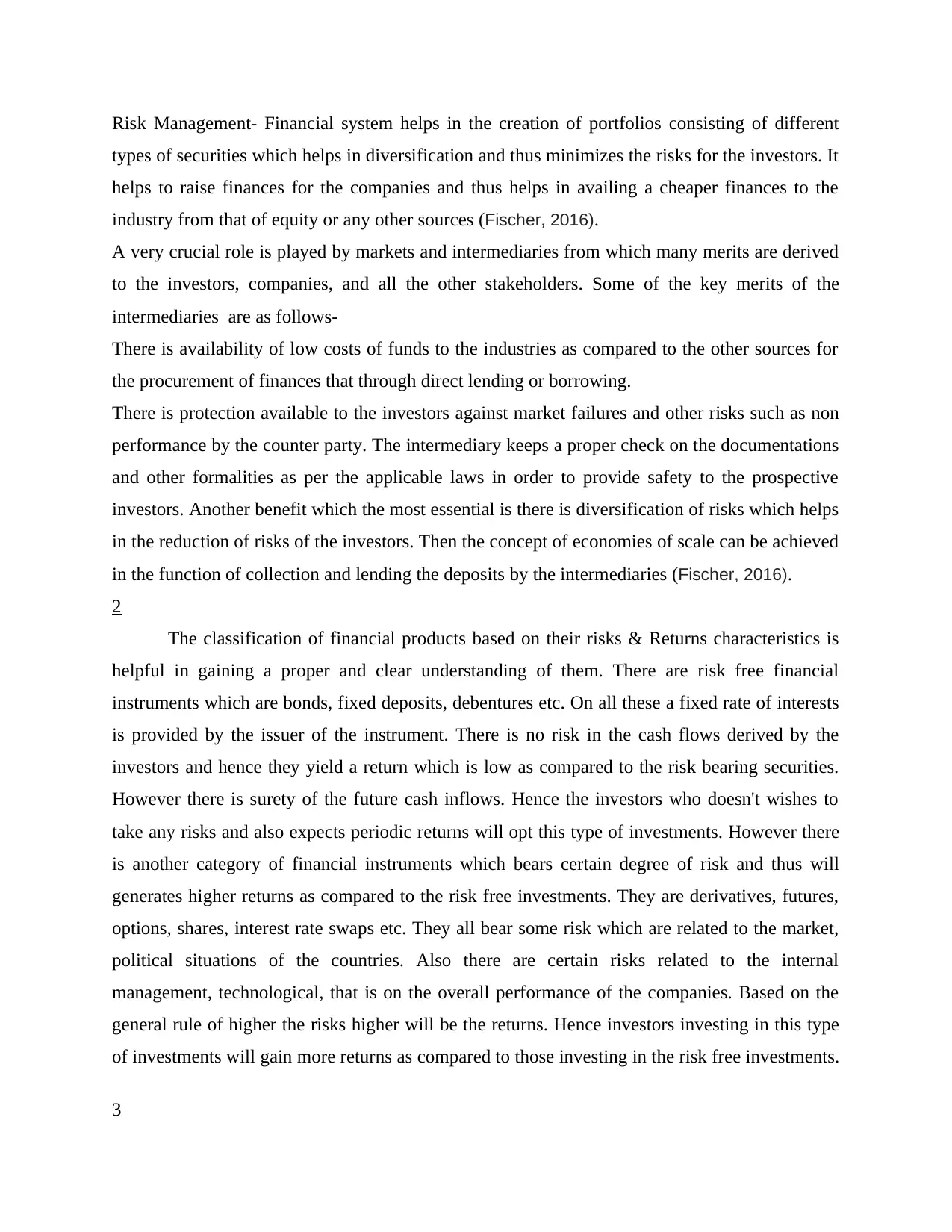
Risk Management- Financial system helps in the creation of portfolios consisting of different
types of securities which helps in diversification and thus minimizes the risks for the investors. It
helps to raise finances for the companies and thus helps in availing a cheaper finances to the
industry from that of equity or any other sources (Fischer, 2016).
A very crucial role is played by markets and intermediaries from which many merits are derived
to the investors, companies, and all the other stakeholders. Some of the key merits of the
intermediaries are as follows-
There is availability of low costs of funds to the industries as compared to the other sources for
the procurement of finances that through direct lending or borrowing.
There is protection available to the investors against market failures and other risks such as non
performance by the counter party. The intermediary keeps a proper check on the documentations
and other formalities as per the applicable laws in order to provide safety to the prospective
investors. Another benefit which the most essential is there is diversification of risks which helps
in the reduction of risks of the investors. Then the concept of economies of scale can be achieved
in the function of collection and lending the deposits by the intermediaries (Fischer, 2016).
2
The classification of financial products based on their risks & Returns characteristics is
helpful in gaining a proper and clear understanding of them. There are risk free financial
instruments which are bonds, fixed deposits, debentures etc. On all these a fixed rate of interests
is provided by the issuer of the instrument. There is no risk in the cash flows derived by the
investors and hence they yield a return which is low as compared to the risk bearing securities.
However there is surety of the future cash inflows. Hence the investors who doesn't wishes to
take any risks and also expects periodic returns will opt this type of investments. However there
is another category of financial instruments which bears certain degree of risk and thus will
generates higher returns as compared to the risk free investments. They are derivatives, futures,
options, shares, interest rate swaps etc. They all bear some risk which are related to the market,
political situations of the countries. Also there are certain risks related to the internal
management, technological, that is on the overall performance of the companies. Based on the
general rule of higher the risks higher will be the returns. Hence investors investing in this type
of investments will gain more returns as compared to those investing in the risk free investments.
3
types of securities which helps in diversification and thus minimizes the risks for the investors. It
helps to raise finances for the companies and thus helps in availing a cheaper finances to the
industry from that of equity or any other sources (Fischer, 2016).
A very crucial role is played by markets and intermediaries from which many merits are derived
to the investors, companies, and all the other stakeholders. Some of the key merits of the
intermediaries are as follows-
There is availability of low costs of funds to the industries as compared to the other sources for
the procurement of finances that through direct lending or borrowing.
There is protection available to the investors against market failures and other risks such as non
performance by the counter party. The intermediary keeps a proper check on the documentations
and other formalities as per the applicable laws in order to provide safety to the prospective
investors. Another benefit which the most essential is there is diversification of risks which helps
in the reduction of risks of the investors. Then the concept of economies of scale can be achieved
in the function of collection and lending the deposits by the intermediaries (Fischer, 2016).
2
The classification of financial products based on their risks & Returns characteristics is
helpful in gaining a proper and clear understanding of them. There are risk free financial
instruments which are bonds, fixed deposits, debentures etc. On all these a fixed rate of interests
is provided by the issuer of the instrument. There is no risk in the cash flows derived by the
investors and hence they yield a return which is low as compared to the risk bearing securities.
However there is surety of the future cash inflows. Hence the investors who doesn't wishes to
take any risks and also expects periodic returns will opt this type of investments. However there
is another category of financial instruments which bears certain degree of risk and thus will
generates higher returns as compared to the risk free investments. They are derivatives, futures,
options, shares, interest rate swaps etc. They all bear some risk which are related to the market,
political situations of the countries. Also there are certain risks related to the internal
management, technological, that is on the overall performance of the companies. Based on the
general rule of higher the risks higher will be the returns. Hence investors investing in this type
of investments will gain more returns as compared to those investing in the risk free investments.
3
⊘ This is a preview!⊘
Do you want full access?
Subscribe today to unlock all pages.

Trusted by 1+ million students worldwide
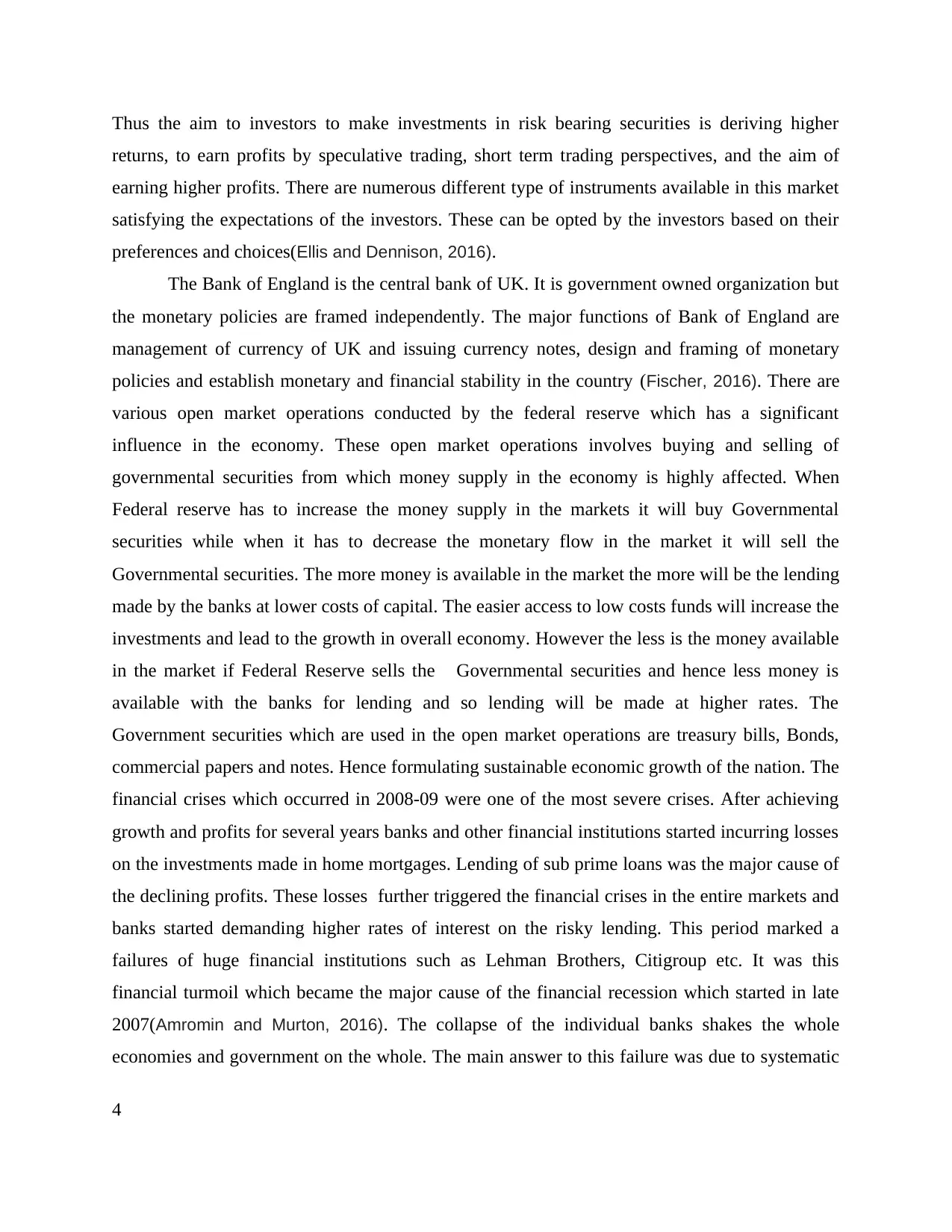
Thus the aim to investors to make investments in risk bearing securities is deriving higher
returns, to earn profits by speculative trading, short term trading perspectives, and the aim of
earning higher profits. There are numerous different type of instruments available in this market
satisfying the expectations of the investors. These can be opted by the investors based on their
preferences and choices(Ellis and Dennison, 2016).
The Bank of England is the central bank of UK. It is government owned organization but
the monetary policies are framed independently. The major functions of Bank of England are
management of currency of UK and issuing currency notes, design and framing of monetary
policies and establish monetary and financial stability in the country (Fischer, 2016). There are
various open market operations conducted by the federal reserve which has a significant
influence in the economy. These open market operations involves buying and selling of
governmental securities from which money supply in the economy is highly affected. When
Federal reserve has to increase the money supply in the markets it will buy Governmental
securities while when it has to decrease the monetary flow in the market it will sell the
Governmental securities. The more money is available in the market the more will be the lending
made by the banks at lower costs of capital. The easier access to low costs funds will increase the
investments and lead to the growth in overall economy. However the less is the money available
in the market if Federal Reserve sells the Governmental securities and hence less money is
available with the banks for lending and so lending will be made at higher rates. The
Government securities which are used in the open market operations are treasury bills, Bonds,
commercial papers and notes. Hence formulating sustainable economic growth of the nation. The
financial crises which occurred in 2008-09 were one of the most severe crises. After achieving
growth and profits for several years banks and other financial institutions started incurring losses
on the investments made in home mortgages. Lending of sub prime loans was the major cause of
the declining profits. These losses further triggered the financial crises in the entire markets and
banks started demanding higher rates of interest on the risky lending. This period marked a
failures of huge financial institutions such as Lehman Brothers, Citigroup etc. It was this
financial turmoil which became the major cause of the financial recession which started in late
2007(Amromin and Murton, 2016). The collapse of the individual banks shakes the whole
economies and government on the whole. The main answer to this failure was due to systematic
4
returns, to earn profits by speculative trading, short term trading perspectives, and the aim of
earning higher profits. There are numerous different type of instruments available in this market
satisfying the expectations of the investors. These can be opted by the investors based on their
preferences and choices(Ellis and Dennison, 2016).
The Bank of England is the central bank of UK. It is government owned organization but
the monetary policies are framed independently. The major functions of Bank of England are
management of currency of UK and issuing currency notes, design and framing of monetary
policies and establish monetary and financial stability in the country (Fischer, 2016). There are
various open market operations conducted by the federal reserve which has a significant
influence in the economy. These open market operations involves buying and selling of
governmental securities from which money supply in the economy is highly affected. When
Federal reserve has to increase the money supply in the markets it will buy Governmental
securities while when it has to decrease the monetary flow in the market it will sell the
Governmental securities. The more money is available in the market the more will be the lending
made by the banks at lower costs of capital. The easier access to low costs funds will increase the
investments and lead to the growth in overall economy. However the less is the money available
in the market if Federal Reserve sells the Governmental securities and hence less money is
available with the banks for lending and so lending will be made at higher rates. The
Government securities which are used in the open market operations are treasury bills, Bonds,
commercial papers and notes. Hence formulating sustainable economic growth of the nation. The
financial crises which occurred in 2008-09 were one of the most severe crises. After achieving
growth and profits for several years banks and other financial institutions started incurring losses
on the investments made in home mortgages. Lending of sub prime loans was the major cause of
the declining profits. These losses further triggered the financial crises in the entire markets and
banks started demanding higher rates of interest on the risky lending. This period marked a
failures of huge financial institutions such as Lehman Brothers, Citigroup etc. It was this
financial turmoil which became the major cause of the financial recession which started in late
2007(Amromin and Murton, 2016). The collapse of the individual banks shakes the whole
economies and government on the whole. The main answer to this failure was due to systematic
4
Paraphrase This Document
Need a fresh take? Get an instant paraphrase of this document with our AI Paraphraser
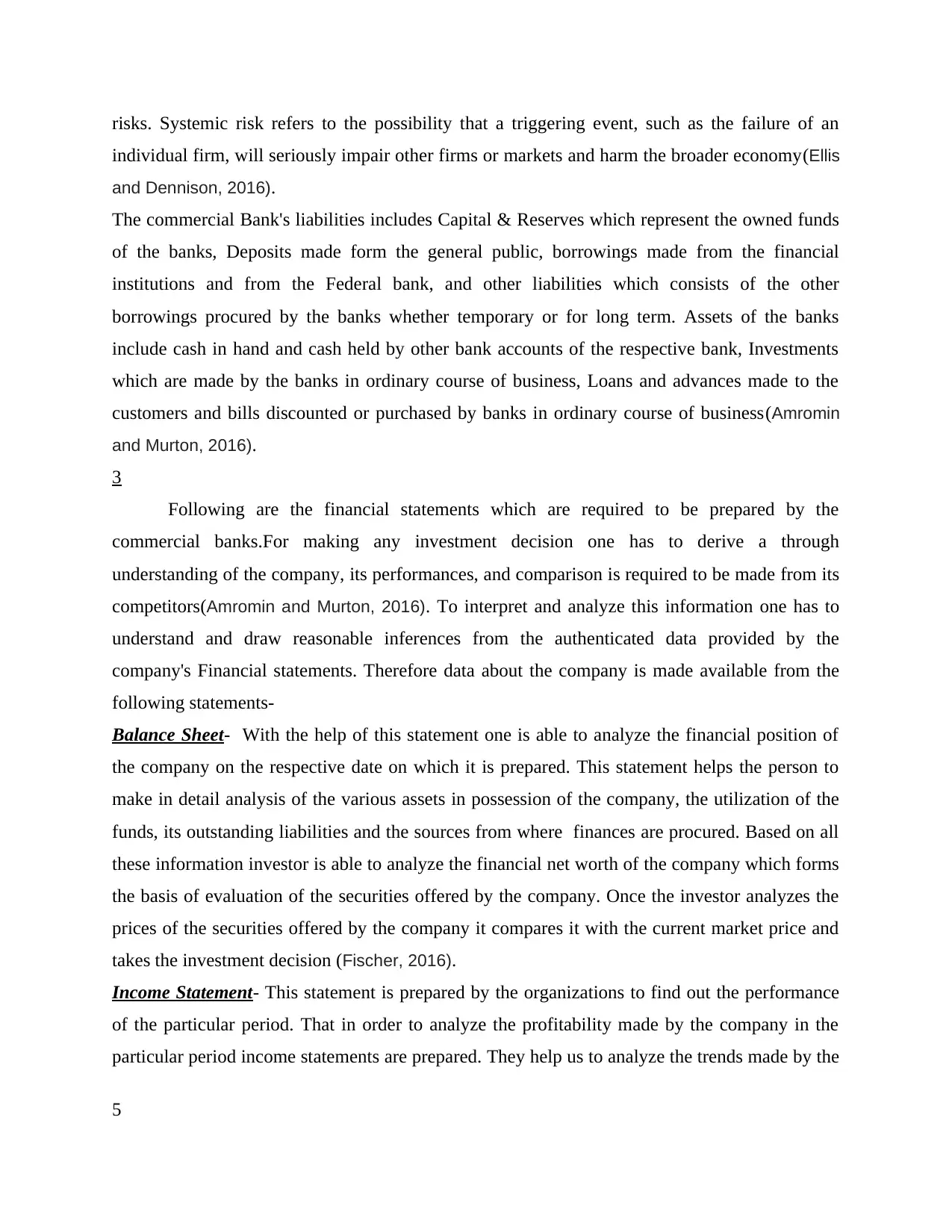
risks. Systemic risk refers to the possibility that a triggering event, such as the failure of an
individual firm, will seriously impair other firms or markets and harm the broader economy(Ellis
and Dennison, 2016).
The commercial Bank's liabilities includes Capital & Reserves which represent the owned funds
of the banks, Deposits made form the general public, borrowings made from the financial
institutions and from the Federal bank, and other liabilities which consists of the other
borrowings procured by the banks whether temporary or for long term. Assets of the banks
include cash in hand and cash held by other bank accounts of the respective bank, Investments
which are made by the banks in ordinary course of business, Loans and advances made to the
customers and bills discounted or purchased by banks in ordinary course of business(Amromin
and Murton, 2016).
3
Following are the financial statements which are required to be prepared by the
commercial banks.For making any investment decision one has to derive a through
understanding of the company, its performances, and comparison is required to be made from its
competitors(Amromin and Murton, 2016). To interpret and analyze this information one has to
understand and draw reasonable inferences from the authenticated data provided by the
company's Financial statements. Therefore data about the company is made available from the
following statements-
Balance Sheet- With the help of this statement one is able to analyze the financial position of
the company on the respective date on which it is prepared. This statement helps the person to
make in detail analysis of the various assets in possession of the company, the utilization of the
funds, its outstanding liabilities and the sources from where finances are procured. Based on all
these information investor is able to analyze the financial net worth of the company which forms
the basis of evaluation of the securities offered by the company. Once the investor analyzes the
prices of the securities offered by the company it compares it with the current market price and
takes the investment decision (Fischer, 2016).
Income Statement- This statement is prepared by the organizations to find out the performance
of the particular period. That in order to analyze the profitability made by the company in the
particular period income statements are prepared. They help us to analyze the trends made by the
5
individual firm, will seriously impair other firms or markets and harm the broader economy(Ellis
and Dennison, 2016).
The commercial Bank's liabilities includes Capital & Reserves which represent the owned funds
of the banks, Deposits made form the general public, borrowings made from the financial
institutions and from the Federal bank, and other liabilities which consists of the other
borrowings procured by the banks whether temporary or for long term. Assets of the banks
include cash in hand and cash held by other bank accounts of the respective bank, Investments
which are made by the banks in ordinary course of business, Loans and advances made to the
customers and bills discounted or purchased by banks in ordinary course of business(Amromin
and Murton, 2016).
3
Following are the financial statements which are required to be prepared by the
commercial banks.For making any investment decision one has to derive a through
understanding of the company, its performances, and comparison is required to be made from its
competitors(Amromin and Murton, 2016). To interpret and analyze this information one has to
understand and draw reasonable inferences from the authenticated data provided by the
company's Financial statements. Therefore data about the company is made available from the
following statements-
Balance Sheet- With the help of this statement one is able to analyze the financial position of
the company on the respective date on which it is prepared. This statement helps the person to
make in detail analysis of the various assets in possession of the company, the utilization of the
funds, its outstanding liabilities and the sources from where finances are procured. Based on all
these information investor is able to analyze the financial net worth of the company which forms
the basis of evaluation of the securities offered by the company. Once the investor analyzes the
prices of the securities offered by the company it compares it with the current market price and
takes the investment decision (Fischer, 2016).
Income Statement- This statement is prepared by the organizations to find out the performance
of the particular period. That in order to analyze the profitability made by the company in the
particular period income statements are prepared. They help us to analyze the trends made by the
5
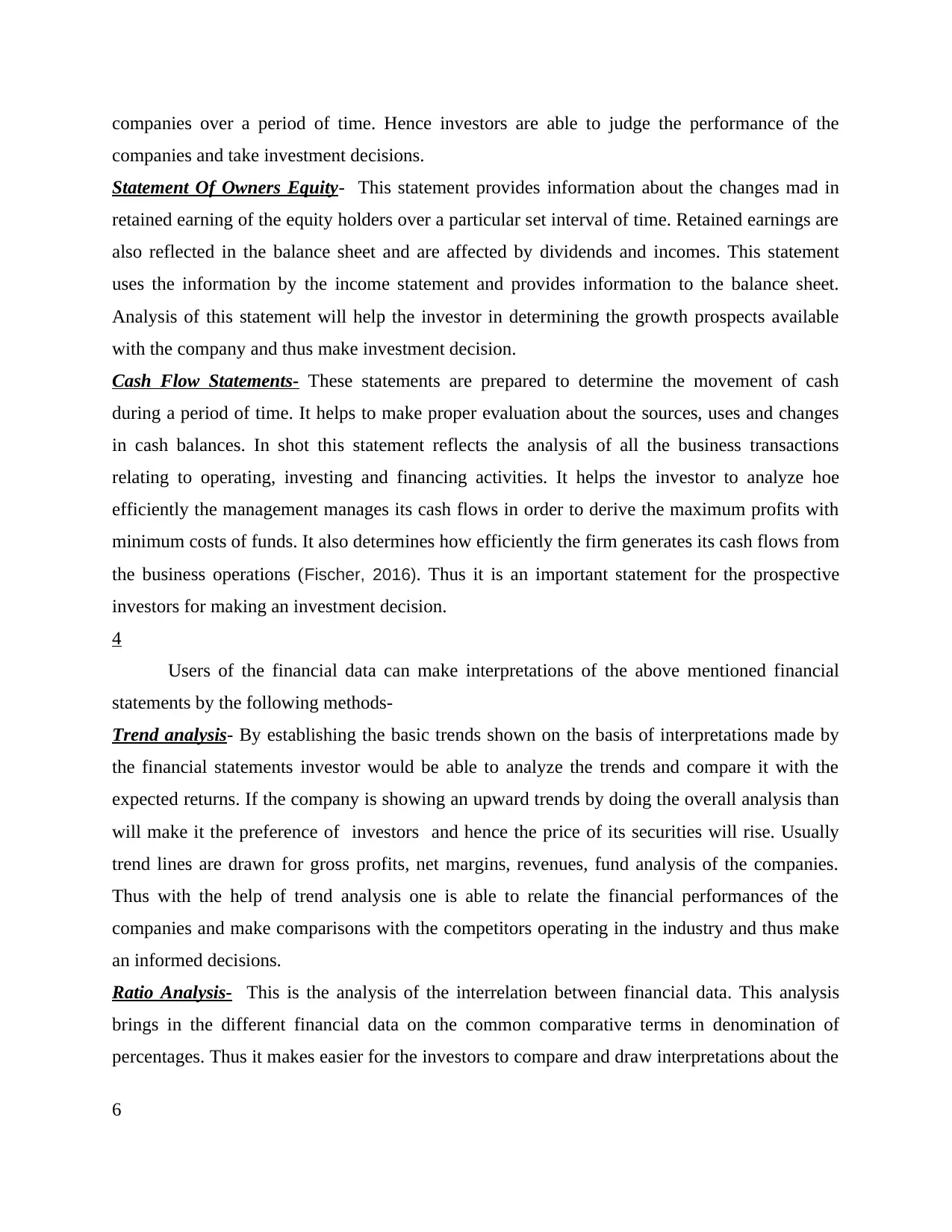
companies over a period of time. Hence investors are able to judge the performance of the
companies and take investment decisions.
Statement Of Owners Equity- This statement provides information about the changes mad in
retained earning of the equity holders over a particular set interval of time. Retained earnings are
also reflected in the balance sheet and are affected by dividends and incomes. This statement
uses the information by the income statement and provides information to the balance sheet.
Analysis of this statement will help the investor in determining the growth prospects available
with the company and thus make investment decision.
Cash Flow Statements- These statements are prepared to determine the movement of cash
during a period of time. It helps to make proper evaluation about the sources, uses and changes
in cash balances. In shot this statement reflects the analysis of all the business transactions
relating to operating, investing and financing activities. It helps the investor to analyze hoe
efficiently the management manages its cash flows in order to derive the maximum profits with
minimum costs of funds. It also determines how efficiently the firm generates its cash flows from
the business operations (Fischer, 2016). Thus it is an important statement for the prospective
investors for making an investment decision.
4
Users of the financial data can make interpretations of the above mentioned financial
statements by the following methods-
Trend analysis- By establishing the basic trends shown on the basis of interpretations made by
the financial statements investor would be able to analyze the trends and compare it with the
expected returns. If the company is showing an upward trends by doing the overall analysis than
will make it the preference of investors and hence the price of its securities will rise. Usually
trend lines are drawn for gross profits, net margins, revenues, fund analysis of the companies.
Thus with the help of trend analysis one is able to relate the financial performances of the
companies and make comparisons with the competitors operating in the industry and thus make
an informed decisions.
Ratio Analysis- This is the analysis of the interrelation between financial data. This analysis
brings in the different financial data on the common comparative terms in denomination of
percentages. Thus it makes easier for the investors to compare and draw interpretations about the
6
companies and take investment decisions.
Statement Of Owners Equity- This statement provides information about the changes mad in
retained earning of the equity holders over a particular set interval of time. Retained earnings are
also reflected in the balance sheet and are affected by dividends and incomes. This statement
uses the information by the income statement and provides information to the balance sheet.
Analysis of this statement will help the investor in determining the growth prospects available
with the company and thus make investment decision.
Cash Flow Statements- These statements are prepared to determine the movement of cash
during a period of time. It helps to make proper evaluation about the sources, uses and changes
in cash balances. In shot this statement reflects the analysis of all the business transactions
relating to operating, investing and financing activities. It helps the investor to analyze hoe
efficiently the management manages its cash flows in order to derive the maximum profits with
minimum costs of funds. It also determines how efficiently the firm generates its cash flows from
the business operations (Fischer, 2016). Thus it is an important statement for the prospective
investors for making an investment decision.
4
Users of the financial data can make interpretations of the above mentioned financial
statements by the following methods-
Trend analysis- By establishing the basic trends shown on the basis of interpretations made by
the financial statements investor would be able to analyze the trends and compare it with the
expected returns. If the company is showing an upward trends by doing the overall analysis than
will make it the preference of investors and hence the price of its securities will rise. Usually
trend lines are drawn for gross profits, net margins, revenues, fund analysis of the companies.
Thus with the help of trend analysis one is able to relate the financial performances of the
companies and make comparisons with the competitors operating in the industry and thus make
an informed decisions.
Ratio Analysis- This is the analysis of the interrelation between financial data. This analysis
brings in the different financial data on the common comparative terms in denomination of
percentages. Thus it makes easier for the investors to compare and draw interpretations about the
6
⊘ This is a preview!⊘
Do you want full access?
Subscribe today to unlock all pages.

Trusted by 1+ million students worldwide
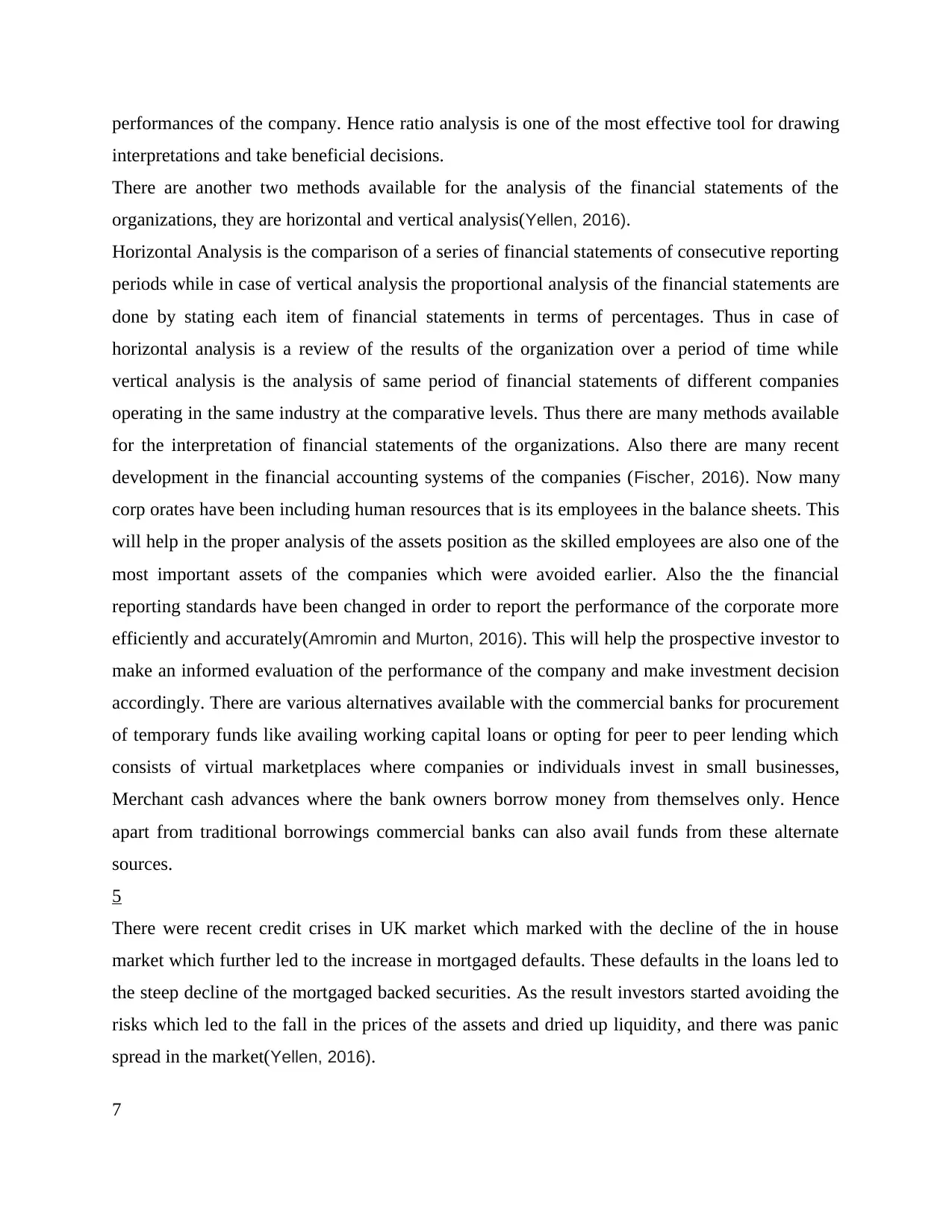
performances of the company. Hence ratio analysis is one of the most effective tool for drawing
interpretations and take beneficial decisions.
There are another two methods available for the analysis of the financial statements of the
organizations, they are horizontal and vertical analysis(Yellen, 2016).
Horizontal Analysis is the comparison of a series of financial statements of consecutive reporting
periods while in case of vertical analysis the proportional analysis of the financial statements are
done by stating each item of financial statements in terms of percentages. Thus in case of
horizontal analysis is a review of the results of the organization over a period of time while
vertical analysis is the analysis of same period of financial statements of different companies
operating in the same industry at the comparative levels. Thus there are many methods available
for the interpretation of financial statements of the organizations. Also there are many recent
development in the financial accounting systems of the companies (Fischer, 2016). Now many
corp orates have been including human resources that is its employees in the balance sheets. This
will help in the proper analysis of the assets position as the skilled employees are also one of the
most important assets of the companies which were avoided earlier. Also the the financial
reporting standards have been changed in order to report the performance of the corporate more
efficiently and accurately(Amromin and Murton, 2016). This will help the prospective investor to
make an informed evaluation of the performance of the company and make investment decision
accordingly. There are various alternatives available with the commercial banks for procurement
of temporary funds like availing working capital loans or opting for peer to peer lending which
consists of virtual marketplaces where companies or individuals invest in small businesses,
Merchant cash advances where the bank owners borrow money from themselves only. Hence
apart from traditional borrowings commercial banks can also avail funds from these alternate
sources.
5
There were recent credit crises in UK market which marked with the decline of the in house
market which further led to the increase in mortgaged defaults. These defaults in the loans led to
the steep decline of the mortgaged backed securities. As the result investors started avoiding the
risks which led to the fall in the prices of the assets and dried up liquidity, and there was panic
spread in the market(Yellen, 2016).
7
interpretations and take beneficial decisions.
There are another two methods available for the analysis of the financial statements of the
organizations, they are horizontal and vertical analysis(Yellen, 2016).
Horizontal Analysis is the comparison of a series of financial statements of consecutive reporting
periods while in case of vertical analysis the proportional analysis of the financial statements are
done by stating each item of financial statements in terms of percentages. Thus in case of
horizontal analysis is a review of the results of the organization over a period of time while
vertical analysis is the analysis of same period of financial statements of different companies
operating in the same industry at the comparative levels. Thus there are many methods available
for the interpretation of financial statements of the organizations. Also there are many recent
development in the financial accounting systems of the companies (Fischer, 2016). Now many
corp orates have been including human resources that is its employees in the balance sheets. This
will help in the proper analysis of the assets position as the skilled employees are also one of the
most important assets of the companies which were avoided earlier. Also the the financial
reporting standards have been changed in order to report the performance of the corporate more
efficiently and accurately(Amromin and Murton, 2016). This will help the prospective investor to
make an informed evaluation of the performance of the company and make investment decision
accordingly. There are various alternatives available with the commercial banks for procurement
of temporary funds like availing working capital loans or opting for peer to peer lending which
consists of virtual marketplaces where companies or individuals invest in small businesses,
Merchant cash advances where the bank owners borrow money from themselves only. Hence
apart from traditional borrowings commercial banks can also avail funds from these alternate
sources.
5
There were recent credit crises in UK market which marked with the decline of the in house
market which further led to the increase in mortgaged defaults. These defaults in the loans led to
the steep decline of the mortgaged backed securities. As the result investors started avoiding the
risks which led to the fall in the prices of the assets and dried up liquidity, and there was panic
spread in the market(Yellen, 2016).
7
Paraphrase This Document
Need a fresh take? Get an instant paraphrase of this document with our AI Paraphraser
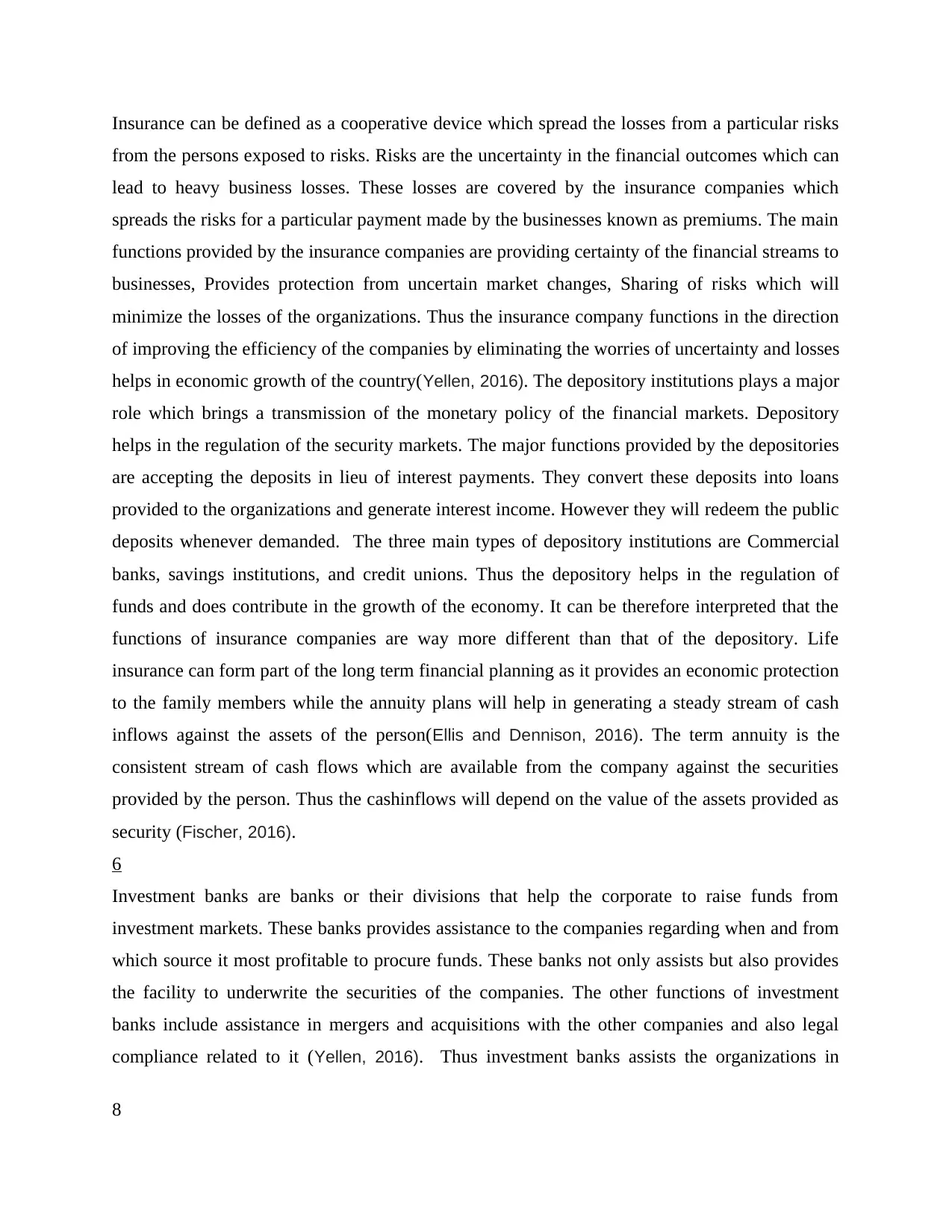
Insurance can be defined as a cooperative device which spread the losses from a particular risks
from the persons exposed to risks. Risks are the uncertainty in the financial outcomes which can
lead to heavy business losses. These losses are covered by the insurance companies which
spreads the risks for a particular payment made by the businesses known as premiums. The main
functions provided by the insurance companies are providing certainty of the financial streams to
businesses, Provides protection from uncertain market changes, Sharing of risks which will
minimize the losses of the organizations. Thus the insurance company functions in the direction
of improving the efficiency of the companies by eliminating the worries of uncertainty and losses
helps in economic growth of the country(Yellen, 2016). The depository institutions plays a major
role which brings a transmission of the monetary policy of the financial markets. Depository
helps in the regulation of the security markets. The major functions provided by the depositories
are accepting the deposits in lieu of interest payments. They convert these deposits into loans
provided to the organizations and generate interest income. However they will redeem the public
deposits whenever demanded. The three main types of depository institutions are Commercial
banks, savings institutions, and credit unions. Thus the depository helps in the regulation of
funds and does contribute in the growth of the economy. It can be therefore interpreted that the
functions of insurance companies are way more different than that of the depository. Life
insurance can form part of the long term financial planning as it provides an economic protection
to the family members while the annuity plans will help in generating a steady stream of cash
inflows against the assets of the person(Ellis and Dennison, 2016). The term annuity is the
consistent stream of cash flows which are available from the company against the securities
provided by the person. Thus the cashinflows will depend on the value of the assets provided as
security (Fischer, 2016).
6
Investment banks are banks or their divisions that help the corporate to raise funds from
investment markets. These banks provides assistance to the companies regarding when and from
which source it most profitable to procure funds. These banks not only assists but also provides
the facility to underwrite the securities of the companies. The other functions of investment
banks include assistance in mergers and acquisitions with the other companies and also legal
compliance related to it (Yellen, 2016). Thus investment banks assists the organizations in
8
from the persons exposed to risks. Risks are the uncertainty in the financial outcomes which can
lead to heavy business losses. These losses are covered by the insurance companies which
spreads the risks for a particular payment made by the businesses known as premiums. The main
functions provided by the insurance companies are providing certainty of the financial streams to
businesses, Provides protection from uncertain market changes, Sharing of risks which will
minimize the losses of the organizations. Thus the insurance company functions in the direction
of improving the efficiency of the companies by eliminating the worries of uncertainty and losses
helps in economic growth of the country(Yellen, 2016). The depository institutions plays a major
role which brings a transmission of the monetary policy of the financial markets. Depository
helps in the regulation of the security markets. The major functions provided by the depositories
are accepting the deposits in lieu of interest payments. They convert these deposits into loans
provided to the organizations and generate interest income. However they will redeem the public
deposits whenever demanded. The three main types of depository institutions are Commercial
banks, savings institutions, and credit unions. Thus the depository helps in the regulation of
funds and does contribute in the growth of the economy. It can be therefore interpreted that the
functions of insurance companies are way more different than that of the depository. Life
insurance can form part of the long term financial planning as it provides an economic protection
to the family members while the annuity plans will help in generating a steady stream of cash
inflows against the assets of the person(Ellis and Dennison, 2016). The term annuity is the
consistent stream of cash flows which are available from the company against the securities
provided by the person. Thus the cashinflows will depend on the value of the assets provided as
security (Fischer, 2016).
6
Investment banks are banks or their divisions that help the corporate to raise funds from
investment markets. These banks provides assistance to the companies regarding when and from
which source it most profitable to procure funds. These banks not only assists but also provides
the facility to underwrite the securities of the companies. The other functions of investment
banks include assistance in mergers and acquisitions with the other companies and also legal
compliance related to it (Yellen, 2016). Thus investment banks assists the organizations in
8
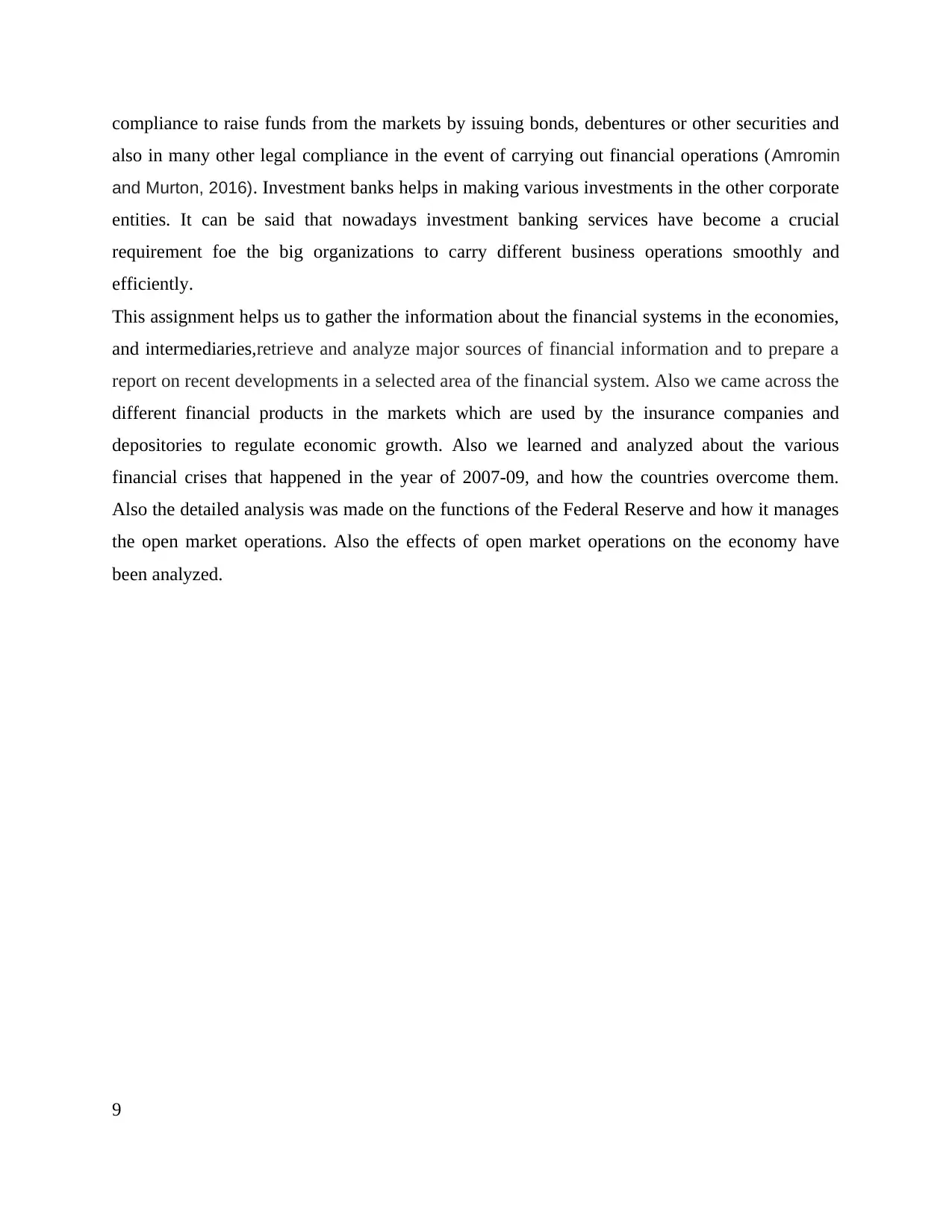
compliance to raise funds from the markets by issuing bonds, debentures or other securities and
also in many other legal compliance in the event of carrying out financial operations (Amromin
and Murton, 2016). Investment banks helps in making various investments in the other corporate
entities. It can be said that nowadays investment banking services have become a crucial
requirement foe the big organizations to carry different business operations smoothly and
efficiently.
This assignment helps us to gather the information about the financial systems in the economies,
and intermediaries,retrieve and analyze major sources of financial information and to prepare a
report on recent developments in a selected area of the financial system. Also we came across the
different financial products in the markets which are used by the insurance companies and
depositories to regulate economic growth. Also we learned and analyzed about the various
financial crises that happened in the year of 2007-09, and how the countries overcome them.
Also the detailed analysis was made on the functions of the Federal Reserve and how it manages
the open market operations. Also the effects of open market operations on the economy have
been analyzed.
9
also in many other legal compliance in the event of carrying out financial operations (Amromin
and Murton, 2016). Investment banks helps in making various investments in the other corporate
entities. It can be said that nowadays investment banking services have become a crucial
requirement foe the big organizations to carry different business operations smoothly and
efficiently.
This assignment helps us to gather the information about the financial systems in the economies,
and intermediaries,retrieve and analyze major sources of financial information and to prepare a
report on recent developments in a selected area of the financial system. Also we came across the
different financial products in the markets which are used by the insurance companies and
depositories to regulate economic growth. Also we learned and analyzed about the various
financial crises that happened in the year of 2007-09, and how the countries overcome them.
Also the detailed analysis was made on the functions of the Federal Reserve and how it manages
the open market operations. Also the effects of open market operations on the economy have
been analyzed.
9
⊘ This is a preview!⊘
Do you want full access?
Subscribe today to unlock all pages.

Trusted by 1+ million students worldwide
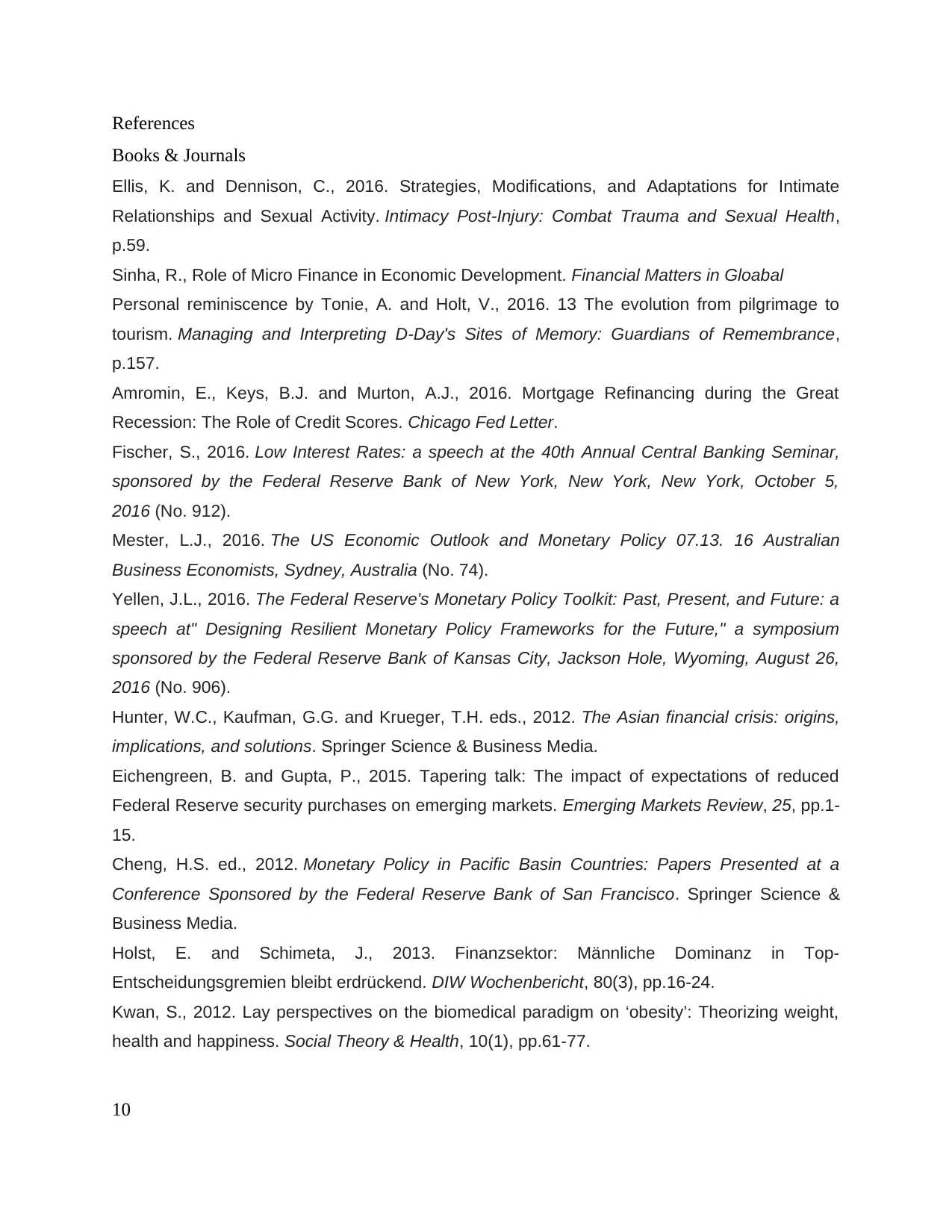
References
Books & Journals
Ellis, K. and Dennison, C., 2016. Strategies, Modifications, and Adaptations for Intimate
Relationships and Sexual Activity. Intimacy Post-Injury: Combat Trauma and Sexual Health,
p.59.
Sinha, R., Role of Micro Finance in Economic Development. Financial Matters in Gloabal
Personal reminiscence by Tonie, A. and Holt, V., 2016. 13 The evolution from pilgrimage to
tourism. Managing and Interpreting D-Day's Sites of Memory: Guardians of Remembrance,
p.157.
Amromin, E., Keys, B.J. and Murton, A.J., 2016. Mortgage Refinancing during the Great
Recession: The Role of Credit Scores. Chicago Fed Letter.
Fischer, S., 2016. Low Interest Rates: a speech at the 40th Annual Central Banking Seminar,
sponsored by the Federal Reserve Bank of New York, New York, New York, October 5,
2016 (No. 912).
Mester, L.J., 2016. The US Economic Outlook and Monetary Policy 07.13. 16 Australian
Business Economists, Sydney, Australia (No. 74).
Yellen, J.L., 2016. The Federal Reserve's Monetary Policy Toolkit: Past, Present, and Future: a
speech at" Designing Resilient Monetary Policy Frameworks for the Future," a symposium
sponsored by the Federal Reserve Bank of Kansas City, Jackson Hole, Wyoming, August 26,
2016 (No. 906).
Hunter, W.C., Kaufman, G.G. and Krueger, T.H. eds., 2012. The Asian financial crisis: origins,
implications, and solutions. Springer Science & Business Media.
Eichengreen, B. and Gupta, P., 2015. Tapering talk: The impact of expectations of reduced
Federal Reserve security purchases on emerging markets. Emerging Markets Review, 25, pp.1-
15.
Cheng, H.S. ed., 2012. Monetary Policy in Pacific Basin Countries: Papers Presented at a
Conference Sponsored by the Federal Reserve Bank of San Francisco. Springer Science &
Business Media.
Holst, E. and Schimeta, J., 2013. Finanzsektor: Männliche Dominanz in Top-
Entscheidungsgremien bleibt erdrückend. DIW Wochenbericht, 80(3), pp.16-24.
Kwan, S., 2012. Lay perspectives on the biomedical paradigm on ‘obesity’: Theorizing weight,
health and happiness. Social Theory & Health, 10(1), pp.61-77.
10
Books & Journals
Ellis, K. and Dennison, C., 2016. Strategies, Modifications, and Adaptations for Intimate
Relationships and Sexual Activity. Intimacy Post-Injury: Combat Trauma and Sexual Health,
p.59.
Sinha, R., Role of Micro Finance in Economic Development. Financial Matters in Gloabal
Personal reminiscence by Tonie, A. and Holt, V., 2016. 13 The evolution from pilgrimage to
tourism. Managing and Interpreting D-Day's Sites of Memory: Guardians of Remembrance,
p.157.
Amromin, E., Keys, B.J. and Murton, A.J., 2016. Mortgage Refinancing during the Great
Recession: The Role of Credit Scores. Chicago Fed Letter.
Fischer, S., 2016. Low Interest Rates: a speech at the 40th Annual Central Banking Seminar,
sponsored by the Federal Reserve Bank of New York, New York, New York, October 5,
2016 (No. 912).
Mester, L.J., 2016. The US Economic Outlook and Monetary Policy 07.13. 16 Australian
Business Economists, Sydney, Australia (No. 74).
Yellen, J.L., 2016. The Federal Reserve's Monetary Policy Toolkit: Past, Present, and Future: a
speech at" Designing Resilient Monetary Policy Frameworks for the Future," a symposium
sponsored by the Federal Reserve Bank of Kansas City, Jackson Hole, Wyoming, August 26,
2016 (No. 906).
Hunter, W.C., Kaufman, G.G. and Krueger, T.H. eds., 2012. The Asian financial crisis: origins,
implications, and solutions. Springer Science & Business Media.
Eichengreen, B. and Gupta, P., 2015. Tapering talk: The impact of expectations of reduced
Federal Reserve security purchases on emerging markets. Emerging Markets Review, 25, pp.1-
15.
Cheng, H.S. ed., 2012. Monetary Policy in Pacific Basin Countries: Papers Presented at a
Conference Sponsored by the Federal Reserve Bank of San Francisco. Springer Science &
Business Media.
Holst, E. and Schimeta, J., 2013. Finanzsektor: Männliche Dominanz in Top-
Entscheidungsgremien bleibt erdrückend. DIW Wochenbericht, 80(3), pp.16-24.
Kwan, S., 2012. Lay perspectives on the biomedical paradigm on ‘obesity’: Theorizing weight,
health and happiness. Social Theory & Health, 10(1), pp.61-77.
10
1 out of 10
Related Documents
Your All-in-One AI-Powered Toolkit for Academic Success.
+13062052269
info@desklib.com
Available 24*7 on WhatsApp / Email
![[object Object]](/_next/static/media/star-bottom.7253800d.svg)
Unlock your academic potential
Copyright © 2020–2025 A2Z Services. All Rights Reserved. Developed and managed by ZUCOL.





